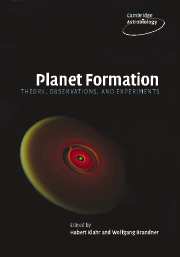Book contents
- Frontmatter
- Contents
- Preface
- Acknowledgments
- 1 Historical notes on planet formation
- 2 The Formation and Evolution of Planetary Systems: placing our Solar System in context
- 3 Destruction of protoplanetary disks by photoevaporation
- 4 Turbulence in protoplanetary accretion disks: driving mechanisms and role in planet formation
- 5 The origin of solids in the early Solar System
- 6 Experiments on planetesimal formation
- 7 Dust coagulation in protoplanetary disks
- 8 The accretion of giant planet cores
- 9 Planetary transits: a first direct vision of extrasolar planets
- 10 The core accretion–gas capture model for gas-giant planet formation
- 11 Properties of exoplanets: a Doppler study of 1330 stars
- 12 Giant-planet formation: theories meet observations
- 13 From hot Jupiters to hot Neptunes … and below
- 14 Disk–planet interaction and migration
- 15 The brown dwarf–planet relation
- 16 Exoplanet detection techniques – from astronomy to astrobiology
- 17 Overview and prospective in theory and observation of planet formation
- References
- Index
13 - From hot Jupiters to hot Neptunes … and below
Published online by Cambridge University Press: 14 September 2009
- Frontmatter
- Contents
- Preface
- Acknowledgments
- 1 Historical notes on planet formation
- 2 The Formation and Evolution of Planetary Systems: placing our Solar System in context
- 3 Destruction of protoplanetary disks by photoevaporation
- 4 Turbulence in protoplanetary accretion disks: driving mechanisms and role in planet formation
- 5 The origin of solids in the early Solar System
- 6 Experiments on planetesimal formation
- 7 Dust coagulation in protoplanetary disks
- 8 The accretion of giant planet cores
- 9 Planetary transits: a first direct vision of extrasolar planets
- 10 The core accretion–gas capture model for gas-giant planet formation
- 11 Properties of exoplanets: a Doppler study of 1330 stars
- 12 Giant-planet formation: theories meet observations
- 13 From hot Jupiters to hot Neptunes … and below
- 14 Disk–planet interaction and migration
- 15 The brown dwarf–planet relation
- 16 Exoplanet detection techniques – from astronomy to astrobiology
- 17 Overview and prospective in theory and observation of planet formation
- References
- Index
Summary
Recent improvements in radial velocity precision
Since the first discovery of an extrasolar planet around a Solar-type star ten years ago (Mayor and Queloz, 1995), research in this field has been very productive and has led to the detection of more than 140 exoplanets. The vast majority of these discoveries has been made with the radial-velocity (RV) technique, i.e. the precise measurement of the RV wobble that a planet induces in its parent star due to its orbital movement. A major effort to improve the accuracy of the RV measurements has been undertaken by several groups, since this is absolutely necessary to detect the RV signatures of giant planets, in the range 1–100 ms−1. Two main techniques were developed: one using a ThAr calibration simultaneously with each observation (Baranne et al., 1996) to track instrumental drifts, and one using an iodine absorption cell, superimposing a reference spectrum on the stellar spectrum (Butler et al., 1996). Both techniques have been able to deliver RV precision at the level of ∼3 ms−1, opening the way to the discovery of many planetary systems.
Over the past decade, the exoplanet group at Geneva Observatory has been operating two high-resolution spectrographs able to achieve high RV precision, namely the ELODIE instrument mounted on the 1.93 m telescope at Observatoire de Haute-Provence (France), and the CORALIE instrument installed on the Swiss 1.2 m telescope at La Silla Observatory (Chile). Both ELODIE and CORALIE are high-resolution (R = 50 000), fiber-fed echelle spectrographs.
- Type
- Chapter
- Information
- Planet FormationTheory, Observations, and Experiments, pp. 203 - 215Publisher: Cambridge University PressPrint publication year: 2006
- 1
- Cited by



